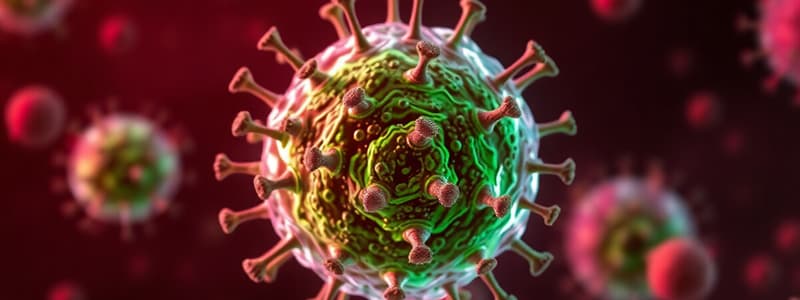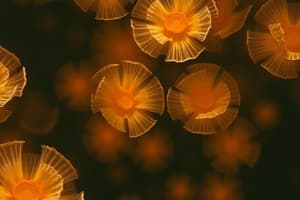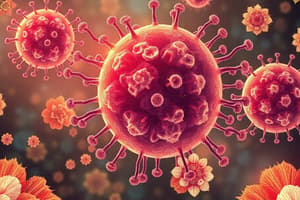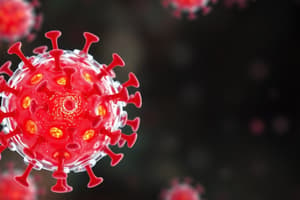Podcast
Questions and Answers
What is the primary function of adhesion molecules in T cell activation?
What is the primary function of adhesion molecules in T cell activation?
- Presenting antigens to T cells
- Strengthening the interaction between T cells and target cells (correct)
- Secreting cytokines to regulate T cell function
- Recognizing specific antigens on target cells
What happens to a naive T cell when it receives a TCR signal but lacks co-stimulation?
What happens to a naive T cell when it receives a TCR signal but lacks co-stimulation?
- The cell undergoes clonal expansion and differentiates into effector T cells.
- The cell remains dormant and awaits further signals.
- The cell becomes anergic or undergoes apoptosis. (correct)
- The cell differentiates into a memory T cell.
Which of the following is NOT a mechanism by which partial T cell activation without co-stimulation contributes to immune tolerance?
Which of the following is NOT a mechanism by which partial T cell activation without co-stimulation contributes to immune tolerance?
- Eliminating self-reactive T cells in the thymus
- Preventing the activation of T cells against harmless antigens.
- Promoting the development of tolerance to self-proteins
- Inducing T cell proliferation and differentiation (correct)
Which molecule expressed on the surface of T cells interacts with co-stimulatory molecules on APCs?
Which molecule expressed on the surface of T cells interacts with co-stimulatory molecules on APCs?
What type of T cell is activated by the interaction of its TCR with antigenic peptide presented by Class II MHC molecules on APCs?
What type of T cell is activated by the interaction of its TCR with antigenic peptide presented by Class II MHC molecules on APCs?
What is the primary function of the CD3 complex in T cell activation?
What is the primary function of the CD3 complex in T cell activation?
What are the polypeptide chains found in the CD3 complex?
What are the polypeptide chains found in the CD3 complex?
Which of the following proteins are co-receptors for the TCR, facilitating its interaction with MHC molecules?
Which of the following proteins are co-receptors for the TCR, facilitating its interaction with MHC molecules?
What is the primary distinction between CD4 and CD8 proteins in terms of their function?
What is the primary distinction between CD4 and CD8 proteins in terms of their function?
Which of the following proteins is involved in the activation of cytotoxic T cells?
Which of the following proteins is involved in the activation of cytotoxic T cells?
Which of the following accessory molecules is expressed on memory T cells?
Which of the following accessory molecules is expressed on memory T cells?
What is the primary role of CD28 in T cell activation?
What is the primary role of CD28 in T cell activation?
What is the role of CD154 (CD40L) in T cell activation?
What is the role of CD154 (CD40L) in T cell activation?
What is a defining characteristic of TH17 cells?
What is a defining characteristic of TH17 cells?
What is the primary role of Tfh cells in the immune system?
What is the primary role of Tfh cells in the immune system?
Which of the following statements is true about TH9 cells?
Which of the following statements is true about TH9 cells?
What is a key difference between Th17 and Treg cell responses?
What is a key difference between Th17 and Treg cell responses?
Which of the following is NOT a characteristic of Treg cells?
Which of the following is NOT a characteristic of Treg cells?
Which type of T cell subset plays a crucial role in the development of antibodies against foreign pathogens?
Which type of T cell subset plays a crucial role in the development of antibodies against foreign pathogens?
Which of the following is NOT a cytokine produced by TH17 cells?
Which of the following is NOT a cytokine produced by TH17 cells?
What is the primary function of IL-9, a cytokine produced by TH9 cells?
What is the primary function of IL-9, a cytokine produced by TH9 cells?
Which of the following cytokines is NOT directly produced by TH2 cells?
Which of the following cytokines is NOT directly produced by TH2 cells?
Which of the following is NOT a characteristic of the TH1 response?
Which of the following is NOT a characteristic of the TH1 response?
In the context of antigen presentation, what is the role of CD40L on the T cell?
In the context of antigen presentation, what is the role of CD40L on the T cell?
What is the main function of TH1 cells in the immune response?
What is the main function of TH1 cells in the immune response?
Which of the following is TRUE regarding the TH2 response?
Which of the following is TRUE regarding the TH2 response?
What is the role of IL-12 in the immune response?
What is the role of IL-12 in the immune response?
Which of the following is NOT a characteristic of TH2 responses?
Which of the following is NOT a characteristic of TH2 responses?
The interaction between CD40L on the T cell and CD40 on the antigen-presenting cell is important for:
The interaction between CD40L on the T cell and CD40 on the antigen-presenting cell is important for:
Which of the following is TRUE regarding the balance between TH1 and TH2 responses?
Which of the following is TRUE regarding the balance between TH1 and TH2 responses?
What is the main function of cytotoxic T lymphocytes (CTLs)?
What is the main function of cytotoxic T lymphocytes (CTLs)?
What is the role of perforin in the killing of target cells by CTLs?
What is the role of perforin in the killing of target cells by CTLs?
What is the role of antigen-presenting DCs in the activation of CD8 T cells?
What is the role of antigen-presenting DCs in the activation of CD8 T cells?
Which of the following is a shared feature of both antibody-dependent and antibody-independent cytotoxicity?
Which of the following is a shared feature of both antibody-dependent and antibody-independent cytotoxicity?
Flashcards
FasL
FasL
A ligand that interacts with its receptor to induce apoptosis in target cells.
Adhesion Molecules
Adhesion Molecules
Proteins that enhance T cell interaction with APCs, promoting activation.
CD4 Helper T Cells
CD4 Helper T Cells
A subset of T cells activated by class II MHC-peptide interactions.
Co-stimulatory Signal
Co-stimulatory Signal
Signup and view all the flashcards
Anergy
Anergy
Signup and view all the flashcards
CD8 T cells
CD8 T cells
Signup and view all the flashcards
Cytotoxic T lymphocytes (CTLs)
Cytotoxic T lymphocytes (CTLs)
Signup and view all the flashcards
Perforin
Perforin
Signup and view all the flashcards
NKT cells
NKT cells
Signup and view all the flashcards
Granzyme
Granzyme
Signup and view all the flashcards
CTLA-4 Binding
CTLA-4 Binding
Signup and view all the flashcards
Antigen Presentation
Antigen Presentation
Signup and view all the flashcards
CD4 T Cell Activation
CD4 T Cell Activation
Signup and view all the flashcards
TH Cell Cytokines
TH Cell Cytokines
Signup and view all the flashcards
IL-12 Role in TH1
IL-12 Role in TH1
Signup and view all the flashcards
TH1 Cytokine Production
TH1 Cytokine Production
Signup and view all the flashcards
Function of Fas Ligand
Function of Fas Ligand
Signup and view all the flashcards
TH1 Response Characteristics
TH1 Response Characteristics
Signup and view all the flashcards
TH2 Response Timing
TH2 Response Timing
Signup and view all the flashcards
Role of IL-4 in TH2
Role of IL-4 in TH2
Signup and view all the flashcards
TH17 cells
TH17 cells
Signup and view all the flashcards
Cytokines produced by TH17
Cytokines produced by TH17
Signup and view all the flashcards
Autoimmune diseases related to TH17
Autoimmune diseases related to TH17
Signup and view all the flashcards
Treg cells
Treg cells
Signup and view all the flashcards
Function of T follicular helper cells (Tfh)
Function of T follicular helper cells (Tfh)
Signup and view all the flashcards
Presence of Tfh in autoimmune diseases
Presence of Tfh in autoimmune diseases
Signup and view all the flashcards
TH9 cells
TH9 cells
Signup and view all the flashcards
Role of Th9 cells
Role of Th9 cells
Signup and view all the flashcards
TCR Complex
TCR Complex
Signup and view all the flashcards
TCR Structure
TCR Structure
Signup and view all the flashcards
TCR Repertoire
TCR Repertoire
Signup and view all the flashcards
CD3 Complex
CD3 Complex
Signup and view all the flashcards
CD4 and CD8
CD4 and CD8
Signup and view all the flashcards
CD4 Binding
CD4 Binding
Signup and view all the flashcards
CD8 Binding
CD8 Binding
Signup and view all the flashcards
Accessory Molecules
Accessory Molecules
Signup and view all the flashcards
Study Notes
Cellular Immunity
- Cellular immunity is a type of immune response that involves the activation of specialized cells to fight off pathogens.
- T cells play a crucial role in this process. They recognize specific antigens presented by other cells in the body, initiating a tailored response to the threat.
Cell Surface Receptors of T cells
- The T cell receptor (TCR) complex is crucial for antigen recognition and activation. This complex consists of the TCR itself, a structure uniquely designed to recognize specific antigens, and the CD3 complex, which facilitates activation signals.
- Each TCR molecule is made up of two different polypeptide chains, similar to antibodies, each with a constant and a variable region. The variable region allows for a vast diversity of TCRs, each capable of recognizing a different antigen.
- The repertoire of TCRs is exceptionally large, capable of recognizing an estimated 1015 separate epitopes (parts of antigens).
- CD3, a complex on the T-cell surface, is part of the TCR complex. It relays the signals triggered by the TCR interacting with an antigen. It's found on all T cells. The CD3 complex consists of ?, ?, ?, and ? polypeptide chains.
- The TCR is the primary tool for the T cell to recognize specific antigens.
- The CD3 complex is the crucial component for transduction of signals from TCR to the interior of the T cell.
T-cell Activation
- Several steps are involved in T cell activation.
- The CD3 complex activates specific transcription factors in the nucleus of the T cell, which leads to the T cell activation.
- This activation also triggers the production of inflammatory mediators, including cytokines such as IL-12, IL-2, and their respective receptors(IL-2R).
TH Cell Activation
- Helper T (TH) cells require two signals for activation: interaction of the T cell receptor (TCR) with an antigen presented by a major histocompatibility complex (MHC)II molecule, and co-stimulatory signals, which involve CD28 on the T cell binding to proteins on the antigen-presenting cell (APC).
- The binding of MHC to the T-cell receptor triggers ITAM phosphorylation.
- ZAP-70 binds and is phosphorylated by this phosphorylation.
CD4/CD8 T cell activation
- CD8 binds to the α3 domain of MHC class I molecules of target cells
- CD4 binds to the β2 domain of MHC class II, presented by antigen-presenting cells.
Cell Surface Receptors of T cells (Accessory molecules)
- Accessory molecules expressed on T cells include CD4, CD8, proteins that act as co-receptors for the TCR, assisting in antigen recognition for T-cells, enhancing activation, and promoting interactions between T cells and antigen presenting cells (APCs) and target cells.
- Other accessory receptors include CD45RA (naive T cells) or CD45RO (memory T cells), CD28 or CTLA-4 (cytotoxic T-cell-associated protein 4), CD154 (CD40L), and FasL, all which play different roles in T-cell function, activation and interaction with other immune cells.
Adhesion Molecules
- Adhesion molecules, like LFA-1, help T cells adhere more tightly to antigen-presenting cells (APCs), ensuring effective interaction and activation.
- Adhesion molecules aid in tight interactions between T cells and APCs.
- These molecules include leukocyte function-associated antigen-1 (LFA-1) that interacts with intercellular adhesion molecules (ICAMs), further strengthening the interaction between T cells and APCs.
Initiation of T Cell Responses
- T cell responses are initiated by antigen-presenting cells (APCs), such as dendritic cells (DCs).
- Helper T cells (CD4 T cells) are activated by the interaction between their TCR and antigenic peptides presented by MHC class II molecules on APCs.
- Co-stimulation, mediated by CD28 on T cells interacting with B7 molecules on APCs, is required for T cell activation and proliferation and growth.
Helper T-cell Subsets
- Different types of helper T cells (TH1, TH2, TH17, Treg, Tfh, Th9) arise from common precursor cells, and are characterized by the cytokines they produce:
- TH1 cells mediate responses to intracellular pathogens and activate cytotoxic T cells and macrophages
- TH2 cells mediate responses to extracellular pathogens and promote antibody production.
- TH17 cells are involved in the inflammatory response to certain pathogens and promote inflammation.
- T regulatory cells (Treg) suppress immune responses to help prevent autoimmunity.
- Tfh (follicular helper T cells) provide help to B cells to produce antibodies
- Th9 cells play a role in antitumor responses.
Antigen Presentation to T cells
- Naive T cell responses are initiated by antigen-presenting cells (APCs), such as dendritic cells (DCs)
- CD4 helper T cells are activated by the interaction between TCR and antigenic peptides presented by MHC class II molecules on APCs.
- Co-stimulatory signals are mediated by binding to proteins on APCs to CD28 molecules on the T cell, inducing T cell growth.
The TH1 Response
- TH1 responses occur early in the course of infection and strengthen cellular and antibody responses.
- TH1 responses amplify local inflammatory reactions and DTH reactions, activating macrophages, NK cells, and CD8 cytotoxic T cells.
- TH1 responses also expand the immune response by promoting growth of B and T cells with IL-12.
The TH2 Response
- TH2 responses act later and work through antibody-mediated responses.
- TH2 responses occur in the absence of IL-12/IFN-Y signals.
- TH2 cells release cytokines including IL-4, IL-5, IL-6, and IL-10, which stimulate B-cell activity.
- These responses are involved in allergies and antibody-mediated responses to parasites.
The TH17 Response
- TH17 cells produce cytokines such as IL-17, IL-22, IL-6, TNF-alpha, and pro-inflammatory chemokines.
- TH17 responses are critical for initial antibacterial and antifungal responses.
- TH17 cells are involved in inflammatory responses in immunoprivileged sites such as the eye.
Treg Cells
- Treg cells are antigen-specific suppressor cells that prevent autoimmune responses by producing TGF-beta and IL-10.
- Treg maintain immune responses under control and promote memory cell development.
NKT cells
- NKT cells are a hybrid between natural killer (NK) cells and T cells.
- They express both NK cell markers and TCRs.
- NKT cells release large amounts of IL-4 and IFN-Y and are important in initial responses to infections, particularly mycobacteria.
CD8 T cytotoxic cell Function
- Activated CD8 T cells, or cytotoxic T lymphocytes (CTLs) differentiate into mature CTLs and interact with target cells.
- Granules containing cytotoxic molecules, like granzymes and perforin, are released into the target cell, inducing apoptosis.
- Perforin creates holes in the target cell membrane, allowing granzymes to enter and trigger apoptosis.
Cytokines and Cytokine Interactions
- Cytokines act as inflammatory messengers, regulating the activity of multiple cells in the immune system.
- Cytokines such as IL-12, IFN-Y, TGF-β and factors that regulate the balance between TH1 and TH2 or other immune responses play a significant role in T-cell activation, differentiation, and the development of specific immune responses.
- Different types of helper T cells, such as TH1, TH2, TH17, and T-regulatory (Tregs) cells, exert crucial regulatory functions by secreting specific sets of cytokines. The interactions between these cytokine profiles are important parameters to control the immune system response.
Studying That Suits You
Use AI to generate personalized quizzes and flashcards to suit your learning preferences.




